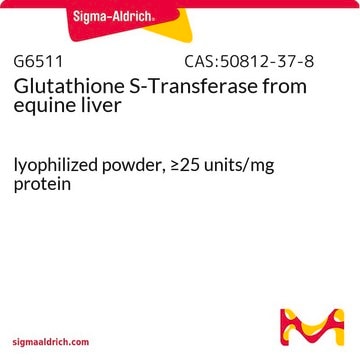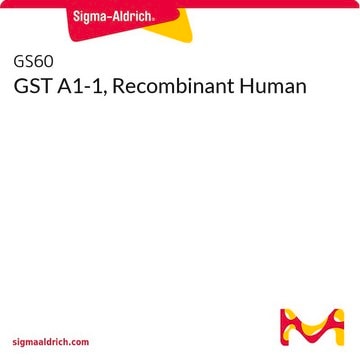CS0410
Glutathione-S-Transferase (GST) Assay Kit
sufficient for 500 multiwell tests
Synonim(y):
GST Enzyme Activity Kit
About This Item
Polecane produkty
zastosowanie
sufficient for 500 multiwell tests
Poziom jakości
Warunki transportu
dry ice
temp. przechowywania
−20°C
informacje o genach
human ... GSTA4(2941) , GSTM1(2944)
Opis ogólny
and erythrocyte lysates
Zastosowanie
Działania biochem./fizjol.
Tylko elementy zestawu
- Dulbecco's Phosphate Buffered Saline 100 mL
- L-Glutathione Reduced 1 g
- GST (Control) .1 mL
- Sample Buffer 5 mL
- Substrate (CDNB) 1.2 mL
Hasło ostrzegawcze
Danger
Zwroty wskazujące rodzaj zagrożenia
Zwroty wskazujące środki ostrożności
Klasyfikacja zagrożeń
Acute Tox. 2 Dermal - Acute Tox. 4 Oral - Aquatic Acute 1 - Aquatic Chronic 1 - Eye Dam. 1 - Skin Irrit. 2 - Skin Sens. 1
Kod klasy składowania
6.1A - Combustible acute toxic Cat. 1 and 2 / very toxic hazardous materials
Temperatura zapłonu (°F)
Not applicable
Temperatura zapłonu (°C)
Not applicable
Certyfikaty analizy (CoA)
Poszukaj Certyfikaty analizy (CoA), wpisując numer partii/serii produktów. Numery serii i partii można znaleźć na etykiecie produktu po słowach „seria” lub „partia”.
Masz już ten produkt?
Dokumenty związane z niedawno zakupionymi produktami zostały zamieszczone w Bibliotece dokumentów.
Klienci oglądali również te produkty
Nasz zespół naukowców ma doświadczenie we wszystkich obszarach badań, w tym w naukach przyrodniczych, materiałoznawstwie, syntezie chemicznej, chromatografii, analityce i wielu innych dziedzinach.
Skontaktuj się z zespołem ds. pomocy technicznej








